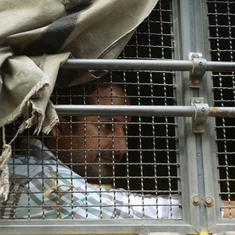RBI cuts repo rate by 50 basis points to 5.5%
This is the third consecutive cut under Governor Sanjay Malhotra, who took office earlier this year.

The Reserve Bank of India’s Monetary Policy Committee on Friday cut the repo rate by 50 basis points, lowering it from 6% to 5.5%.
This is the third consecutive cut under Governor Sanjay Malhotra, who took office earlier this year. In April, the committee had cut the repo rate by 25 basis points, lowering it to 6% from 6.25%.
The repo rate is the interest rate at which the central bank lends money to commercial banks. The Monetary Policy Committee decides on changes to it every two months.
A basis point is one-hundredth of a percentage point. Basis points are used to describe the percentage change in the value of a financial instrument.
Central banks usually reduce repo rates to stimulate economic growth by making borrowing cheaper for individuals and businesses. This translates to lower equated monthly instalments for borrowers.
#WATCH | RBI Governor Sanjay Malhotra says, "... The MPC decided to reduce the policy Repo Rate under the liquidity adjustment facility by 50 basis points to 5.5%. This will be with immediate effect. Consequently, the Standing Deposit Facility (STF) Rate shall stand adjusted to… pic.twitter.com/siUUlBmcrG
— ANI (@ANI) June 6, 2025
During a press briefing on Friday, Malhotra said that the Reserve Bank has changed its monetary policy stance from “accommodative” to “neutral”.
A neutral stance means that the Reserve Bank remained flexible in adjusting policy rates based on prevailing economic conditions. In contrast, a withdrawal of accommodation is a restrictive stance where the central bank aims to reduce the money supply in the economy by increasing interest rates to curb inflationary pressures.
The governor also said that the standing deposit facility rate shall was adjusted to 5.25% and the marginal standing facility rate and the bank rate to 5.75%.
The standing deposit facility is a tool to absorb liquidity from commercial banks without giving government securities to them in return. The marginal standing facility rate is a penal rate at which banks can borrow money from RBI when they are completely exhausted of all borrowing assistance.
The bank rate, also known as the discount rate or base rate, is the interest rate at which the Reserve Bank of India lends money to commercial banks.
The Reserve Bank has retained India’s growth projection for the financial year 2025-’26 at 6.5% despite global uncertainties, with quarterly estimates unchanged.
Malhotra said that the meeting of the Monetary Policy Committee was held in the backdrop of an early and promising start to the monsoon season.
“In contrast, the global backdrop remains fragile and highly fluid,” he said. “The uncertainty around the global economic outlook has somewhat ebbed since the MPC [Monetary Policy Committee] met in April in the wake of temporary tariff reprieve and optimism around trade negotiations.”
On April 2, the United States announced “reciprocal” tariffs on dozens of countries, including a 26% “discounted” levy on India. Trump had repeatedly said he intended to impose a reciprocal tax on India, among others, citing the high tariffs the countries impose on foreign goods.
On April 9, the so-called reciprocal tariffs imposed by the US on several countries took effect. Hours after, however, Trump reduced the tariff rates on imports from most countries to 10% for 90 days to provide time for trade negotiations.









